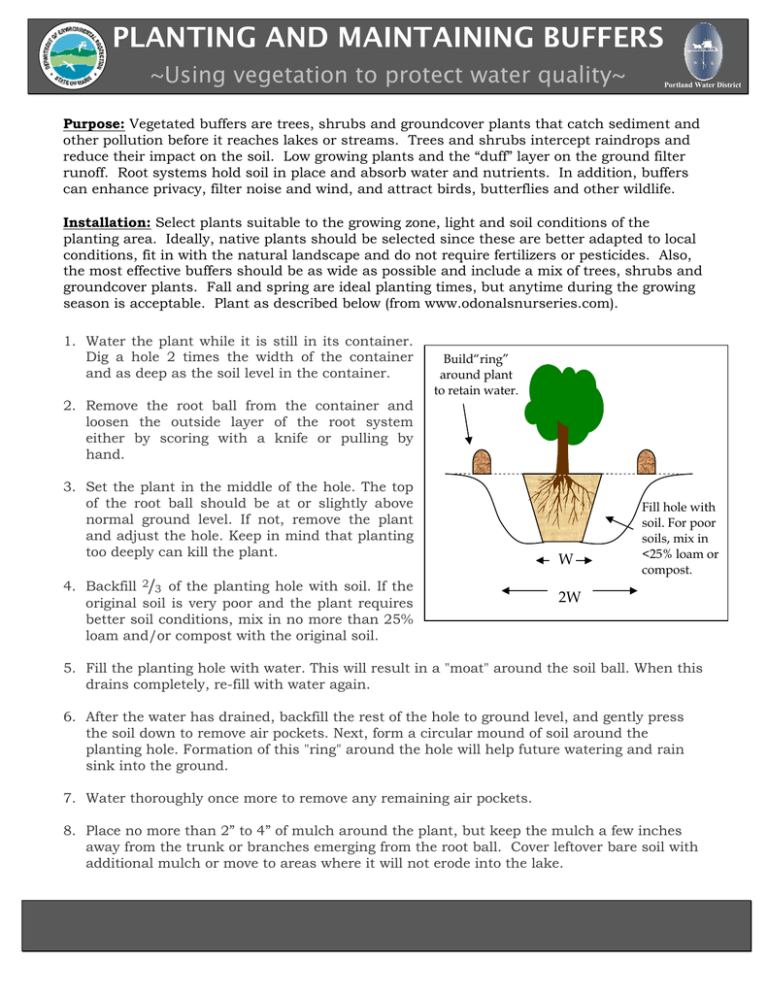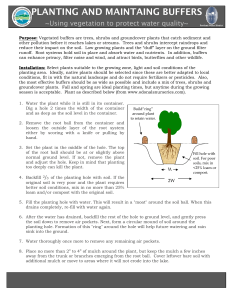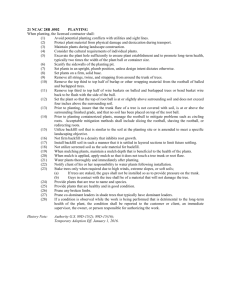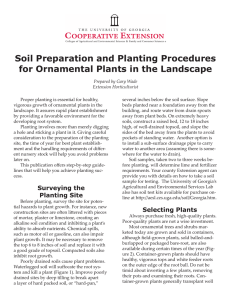PLANTING AND MAINTAINING BUFFERS ~Using vegetation to protect water quality~
advertisement

PLANTING AND MAINTAINING BUFFERS ~Using vegetation to protect water quality~ Portland Water District Purpose: Vegetated buffers are trees, shrubs and groundcover plants that catch sediment and other pollution before it reaches lakes or streams. Trees and shrubs intercept raindrops and reduce their impact on the soil. Low growing plants and the “duff” layer on the ground filter runoff. Root systems hold soil in place and absorb water and nutrients. In addition, buffers can enhance privacy, filter noise and wind, and attract birds, butterflies and other wildlife. Installation: Select plants suitable to the growing zone, light and soil conditions of the planting area. Ideally, native plants should be selected since these are better adapted to local conditions, fit in with the natural landscape and do not require fertilizers or pesticides. Also, the most effective buffers should be as wide as possible and include a mix of trees, shrubs and groundcover plants. Fall and spring are ideal planting times, but anytime during the growing season is acceptable. Plant as described below (from www.odonalsnurseries.com). 1. Water the plant while it is still in its container. Dig a hole 2 times the width of the container and as deep as the soil level in the container. 2. Remove the root ball from the container and loosen the outside layer of the root system either by scoring with a knife or pulling by hand. Build“ring” around plant to retain water. 3. Set the plant in the middle of the hole. The top of the root ball should be at or slightly above normal ground level. If not, remove the plant and adjust the hole. Keep in mind that planting too deeply can kill the plant. 4. Backfill 2/3 of the planting hole with soil. If the original soil is very poor and the plant requires better soil conditions, mix in no more than 25% loam and/or compost with the original soil. W Fill hole with soil. For poor soils, mix in <25% loam or compost. 2W 5. Fill the planting hole with water. This will result in a "moat" around the soil ball. When this drains completely, re-fill with water again. 6. After the water has drained, backfill the rest of the hole to ground level, and gently press the soil down to remove air pockets. Next, form a circular mound of soil around the planting hole. Formation of this "ring" around the hole will help future watering and rain sink into the ground. 7. Water thoroughly once more to remove any remaining air pockets. 8. Place no more than 2” to 4” of mulch around the plant, but keep the mulch a few inches away from the trunk or branches emerging from the root ball. Cover leftover bare soil with additional mulch or move to areas where it will not erode into the lake. Materials: Plants and bags of compost and loam can be purchased from local nurseries. Plant Hardiness Zones in Maine Maintenance: Year One Deep, weekly watering is a must during the first year of planting. Most plants that die in the first season do so because of inadequate watering. Make sure that the water reaches the depth of the root ball. The “ring” around the plant helps the water sink into the ground instead of running off. Planting areas can be weeded, but should not be raked. After One Year After the first year, you should only need to water if there is a lack of normal rainfall. Once the plants are well established, you can let the planted area naturalize so that you do not need to replenish mulch or weed. The “duff” layer of leaves and pine needles will serve as natural mulch. Applying Fertilizer If plants appear to be growing well, they should not require fertilization. Fertilizer can actually harm newly developing roots, and summer/fall applications can prevent shrubs and trees from hardening off in time for winter. Shrubs and trees should only be fertilized in early spring, and only after a soil test has been performed. Transplanting: You can save money by transplanting native plants into your buffer area. Keep in mind, however, that mortality rates of transplants is relatively high. Here are some general transplanting guidelines: • Make sure to ask for landowner permission before harvesting and do not take too many plants from any one area. Do not remove plants next to lakes or streams. • Transplant in the early spring or late fall when the plants are dormant. This reduces trauma to their root systems. • Choose sturdy-looking plants. Dig up the root ball as much as possible (extend your digging area at least to the width of the plant’s branches.) • Once your transplant has been replanted, water frequently until well established. Before After Part of the Conservation Practices for Homeowners Factsheet Series, available at: Maine DEP (800.452.1942); http://www.maine.gov/dep/blwq/docwatershed/materials.htm Portland Water District (207.774.5961); http://www.pwd.org/news/publications.php January 2009 DEPLW-0826







